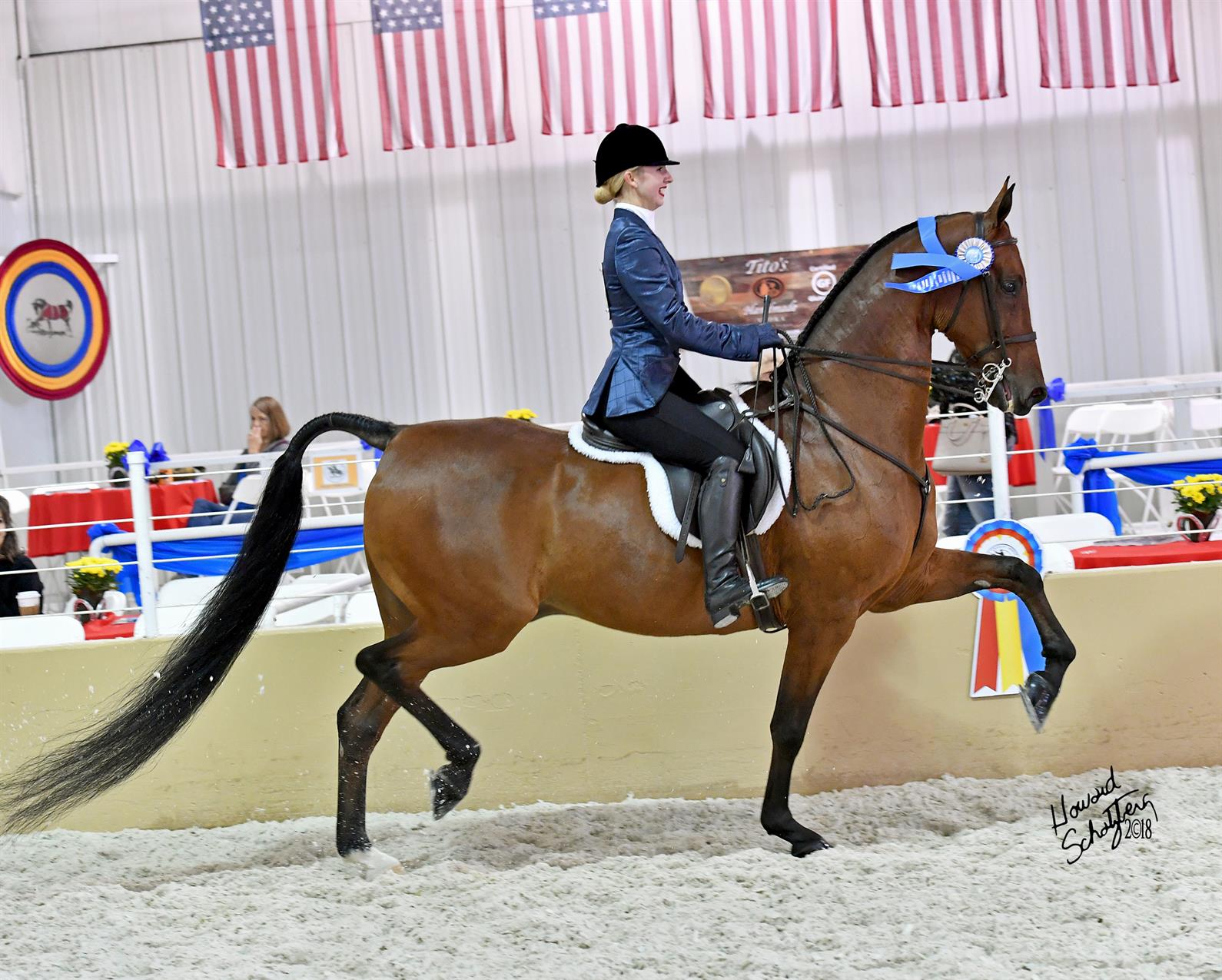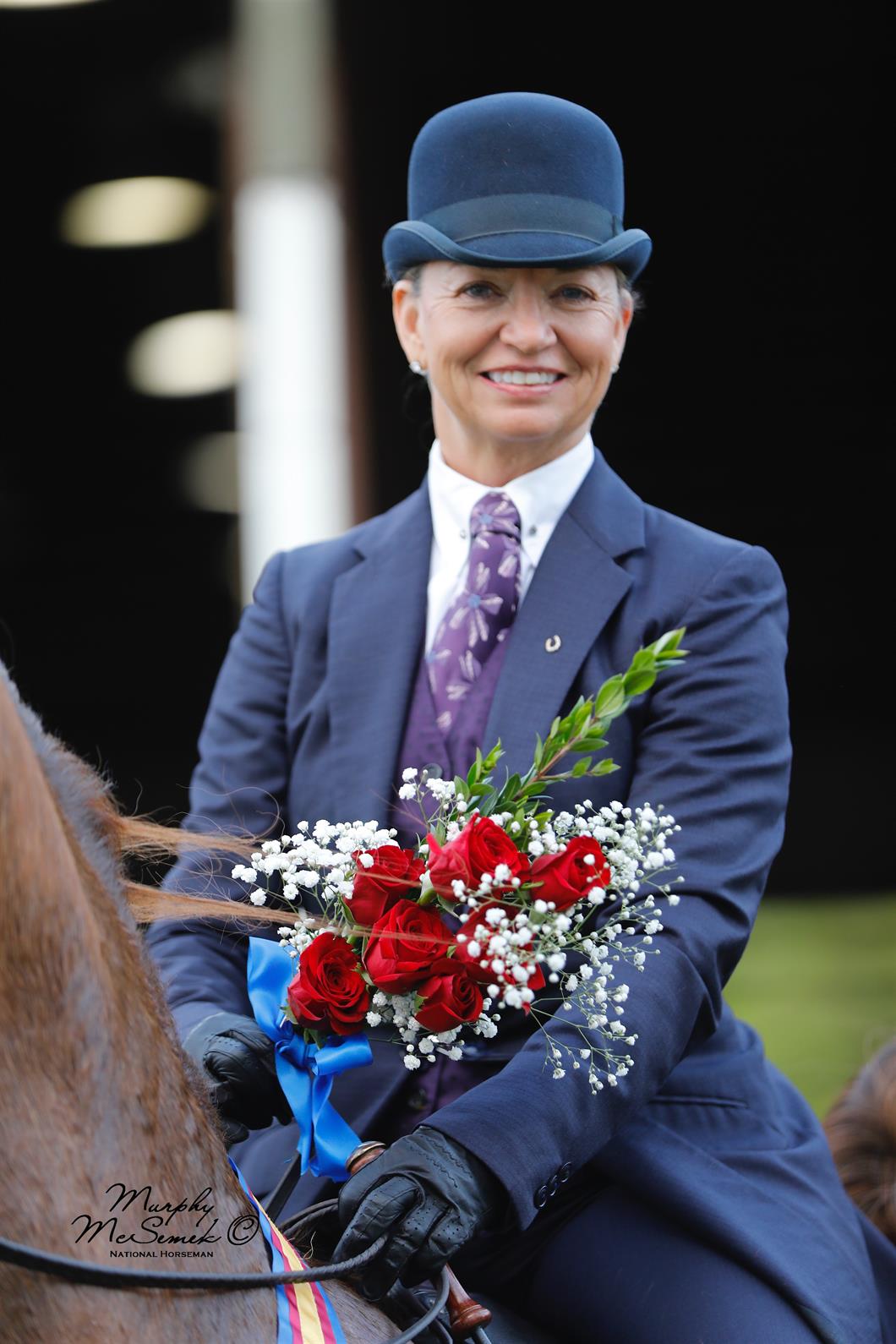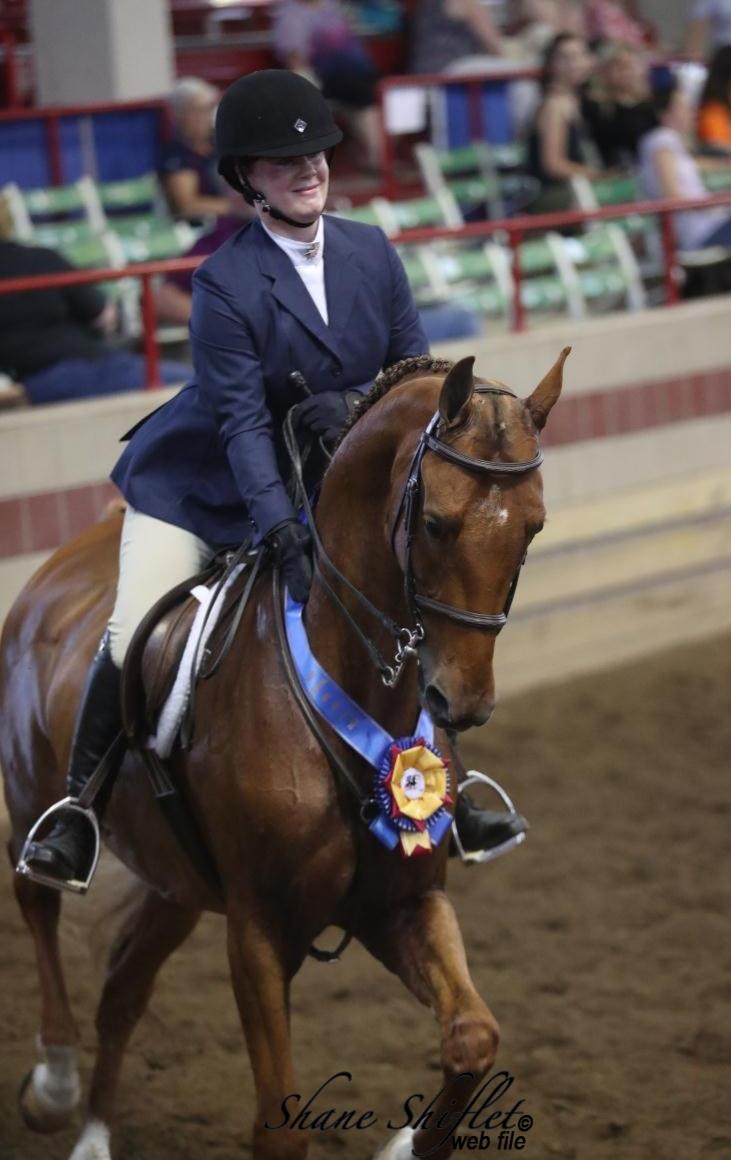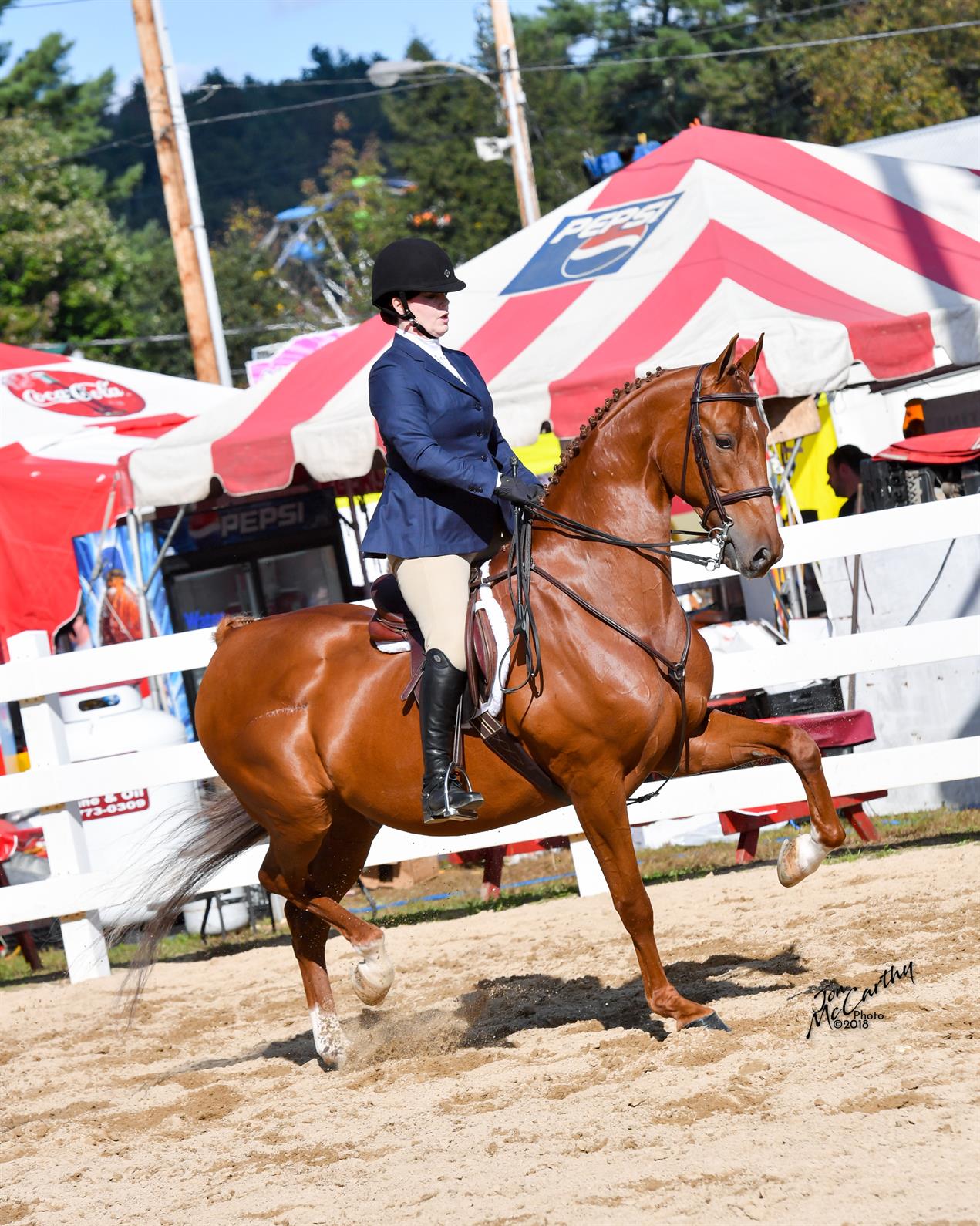The historic World’s Championship Horse Show, which takes place Aug. 17-24 in Louisville, Ky., is already underway. And this year, supporters of the popular American Saddlebred hunter country pleasure division will be celebrating the competition with even more enthusiasm than usual, as the 2019 show marks that division’s debut at the World’s Championship.

Photo: Howard Schatzberg
“I think it’s always helpful to have another venue for our horses to show what a wonderfully athletic, intelligent, and versatile breed they are,” said Sandra “Sandy” Currier, a USEF-licensed judge and the American Saddlebred Registry’s current president.
The division is open to the top 20 hunter country pleasure horses in the country, and one who made the cut is Phyllis Brannon’s CHHarlem’s Sweet Success, nicknamed Danny. When the American Saddlebred Horse Association announced last year that the hunter country pleasure division would be included in the 2019 WCHS, Brannon (Pittsburgh, Pa.) postponed Danny’s retirement from competition to get him qualified for Louisville. Today, he’s among the nation’s top 20 ranked hunter country pleasure horses who will take to Louisville’s famed green shavings this week. Brannon’s 20-year-old daughter Caitlin will show Danny at the WCHS.
“This is such a great division for the American Saddlebred,” Brannon said. “It helps to bring people from outside the Saddlebred world into our world, and they can show and compete. People who already know hunt seat look at this and say, ‘Oh, hunt seat, I can do that!’ It’s such a great promotion of the versatility of our horses.
“He’ll probably retire from showing after this,” Brannon added, noting that Danny will continue his work as a therapeutic riding horse and a mount in local 4-H shows.
The American Saddlebred hunter country pleasure riders compete in traditional hunt seat attire, wearing tall boots, a hunt coat, and a hunt cap-style helmet. But hunter and hunter seat equitation riders will note some differences in the American Saddlebred hunter country pleasure division’s equine athletes, who generally have a higher step and a higher head carriage than those in the hunter ring. But manners and consistency are just as important to the American Saddlebred competitors as they are to their hunter-ring counterparts.
“Manners come first,” said Currier, who also breeds and trains American Saddlebreds. “They have to be mannerly. I like to see a

Photo: Murphy McSemek/National Horseman
horse who is quiet in the bridle, not pulling or tugging or unduly restrained. I like a medium headset, neither too high nor too low. I wouldn’t be averse to seeing a headset similar to that in the hunter ring, if the horse has a nice rainbow neck, his face is perpendicular to the ground, and he has manners.”
The hunter country pleasure classes in Louisville do not require any jumping, although there is an over-fences final at the St. Louis Horse Show, which offers hunter jumper competition Sept. 11-15 and Saddlebred and Hackney competition Sept. 25-28. There, Currier said, competitors typically also have the opportunity to take a mini-clinic with a hunter professional.
Even when jumping isn’t involved, as at Louisville, Currier said, “When I’m looking at the horse, I want it to be one that, if it saw a jump, it could go over it.
“We want to see forward motion and a ground-covering stride,” Currier added. “We don’t want to see a horse stepping super-high without also going forward. If they have a nice rolling trot that’s extended, that’s fine, but they should have some forward-reaching motion.”
At the extended canter—which replaces the hunter world's hand gallop as one of the gaits in the class—the horse should have a rolling but collected canter, Currier said.
“The horse also should have quality,” she said. “We like to see a pretty face, a good eye, a properly balanced body. Conformation is part of our judging.
“I would love to see our division evolve to where we have honest-to-goodness hunters who could, say, go to Devon in the spring and show in both the hunter division and the Saddlebred hunter division and be top of the class in both," she added.
Brannon, Danny’s owner, says she’s debating taking Danny to Devon in the fall for an entirely different discipline—Dressage at Devon, Sept. 24-29. She says the Saddlebred’s athleticism and attitude make anything possible.
“They’re so willing to please,” Brannon said. “They’re a people horse; they want to be with you. They have personality and like to interact with people.

Photo: Shane Shiflet
“We bought Danny as Caitlin’s beginner saddle seat horse, and we started showing some local shows and 4-H. She did walk-trot classes on him. As she got more comfortable with him and as he started stepping up his game a little bit, we thought we’d try him in the hunt division, because he’s made to be a hunter. He’s more of an open-moving horse who has extension to his trot; he’s not a high-headed Saddlebred, but he’s very sporty. He loved this division and excelled in it.
“As an amateur owner/trainer who does everything myself, it’s easy for me to compete in the hunter country pleasure classes,” Brannon explained. “I don’t live in Kentucky, where there are a lot of Saddlebreds. I live north of Pittsburgh, where it’s hunter jumper world. Danny’s boarded at a stable with a bunch of hunter horses and 4-H horses. A hunter country pleasure horse is something I can keep at home, train myself, and have my Quarter Horse farrier shoe, because I don’t have access to a Saddlebred shoeing specialist.”
For Tracey Cimikowski (Maynard, Mass.), the hunter country pleasure division helped draw her back to competition after almost a decade away from showing.
“My father died in 2009 and then my husband died, and I thought, ‘I’m never going to have a horse again, and that’s okay,’” she recalled. “I just felt I wasn’t financially or mentally able to do it. But I’d showed for 30 years, and giving it up was very hard. Then one day my mom said, ‘Would you like another horse?’ And I said, ‘Yes!’”
Cimikowski, who had shown hunter jumpers as a child before switching to saddle seat’s pleasure and country pleasure divisions, bought her current Saddlebred, 10-year-old Jimmy Jack, from Jannie Giles in Kentucky. “He’s very large and impressive, which is nice, but he’s so gentle and shy, too,” said Cimikowski, who trains with John and Sheri Lampropoulos in Newton, N.H.
Cimikowski and Jimmy Jack have enjoyed huge success in the hunter country pleasure division and just missed qualifying for the division’s debut at WCHS this year. But Cimikowski says she’s planning to be there in 2020. “I was totally thrilled they added it this year,” she said. “The first time having hunters on the green shavings is very special. It’s important for the breed.”
The hunter country pleasure division offers a welcoming and budget-friendly way to show Saddlebreds, Cimikowski says, but it’s also highly competitive and challenging.

Photo: Jon McCarthy
“In the hunter division, if you really work hard and your horse is consistent, you can do well,” Cimikowski said. “That consistency is really important in the hunter country pleasure division; you can’t make mistakes. You have to have a clean ride, and, after that, having a horse like Jimmy, who’s a nice mover and pretty and uses his ears, that helps, too. Jimmy’s a really beautiful mover and perfect in the bridle, but if we mess up, well, we’re not going to get a ribbon.
“I like that Saddlebreds are so easy to handle,” Cimikowski added. “Saddlebreds are so easy when you’re grooming, shipping, everything. And they’re so gentle and pretty! They also have a lot of diversity. I’ve done Western, driving, saddle seat, and now hunter. It’s a lot of fun. They’re just so willing, and no matter what you do with them, they try.”
That versatililty and fun is what Saddlebred enthusiasts and professionals are hoping more people will discover.
“I’m hoping that more people will start looking at our breed and seeing that we’re not only about the fancy three- and five-gaited horses that you see in the pictures,” Currier said. “They’re really a versatile breed, and they have a nice size and scope to them, so they’re very useful.”
Learn more about the American Saddlebred at the American Saddlebred Horse Association and on US Equestrian’s American Saddlebred page and in our online Learning Center, where you can watch “American Saddlebred: What Makes a Winner” with trainer Smith Lilly.
Want articles like this delivered to your inbox every week? Sign up to receive the Equestrian Weekly newsletter here.
This article is original content produced by US Equestrian and may only be shared via social media. It is not to be repurposed or used on any other website than USequestrian.org.


